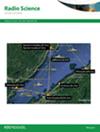优化雷达功能:开发带宽更高的可转向贴片天线阵列
IF 1.5
4区 地球科学
Q3 ASTRONOMY & ASTROPHYSICS
引用次数: 0
摘要
如今,无线通信系统需要一种具有高增益、高效率、波束转向和宽带能力的天线,这在雷达通信中尤为重要。由于阵列天线具有高增益和宽带宽等优点,因此在许多应用中得到了普遍使用。本文介绍了一种用于重要雷达应用的水平可转向平面天线阵列的先进设计。本文采用一种新颖的结构来创建一个由 8 × 3 个元件组成的紧凑型阵列天线。该设计采用 8 × 3 平面阵列的新颖配置,具有全面的 60° 转向扇区和显著的 12% 带宽(4.45-5.42 GHz)。它采用了三元件串联馈电垂直阵列,利用孔径馈电和精确尺寸的贴片来最大限度地提高性能。报告详细描述了该阵列的设计和改进过程,重点介绍了它在水平转向和带宽效率方面的卓越能力。通过采用具有可变贴片尺寸的串联馈电垂直阵列,我们成功地开发出一种天线阵列,满足了雷达技术所必需的严格带宽要求,从而提高了雷达系统的操作多样性。本文章由计算机程序翻译,如有差异,请以英文原文为准。
Optimizing radar functionality: Development of a steerable patch antenna array with enhanced bandwidth
Today, wireless communication systems need an antenna with a high gain, efficiency and beamsteering, as well as broadband capability, especially important in radar communications. The array antenna is commonly used in many applications due to its advantages, such as high gain and wide bandwidth. This paper presents an advanced design of a horizontally steerable planar antenna array intended for significant radar applications. A novel structure is used to create a compact array antenna of 8 × 3 elements. The design features a comprehensive 60° steering sector alongside a notable 12% bandwidth (4.45—5.42 GHz), using 8 × 3 planar array in an novel configuration. A three-element series-fed vertical array is utilized, employing aperture feeds with precisely sized patches to maximize performance. A detailed description of the design and refinement process of this array is presented, with emphasis on its exceptional capabilities for horizontal steering and bandwidth efficiency. By employing series-fed vertical arrays with variable patch dimensions, we have successfully developed an antenna array that meets the stringent bandwidth requirements essential for radar technology, thereby enhancing the operational versatility of radar systems.
求助全文
通过发布文献求助,成功后即可免费获取论文全文。
去求助
来源期刊

Radio Science
工程技术-地球化学与地球物理
CiteScore
3.30
自引率
12.50%
发文量
112
审稿时长
1 months
期刊介绍:
Radio Science (RDS) publishes original scientific contributions on radio-frequency electromagnetic-propagation and its applications. Contributions covering measurement, modelling, prediction and forecasting techniques pertinent to fields and waves - including antennas, signals and systems, the terrestrial and space environment and radio propagation problems in radio astronomy - are welcome. Contributions may address propagation through, interaction with, and remote sensing of structures, geophysical media, plasmas, and materials, as well as the application of radio frequency electromagnetic techniques to remote sensing of the Earth and other bodies in the solar system.
 求助内容:
求助内容: 应助结果提醒方式:
应助结果提醒方式:


